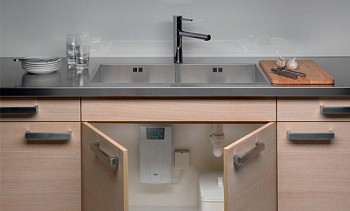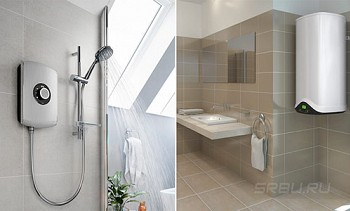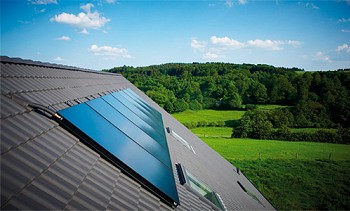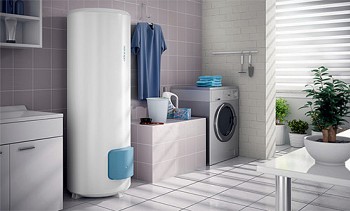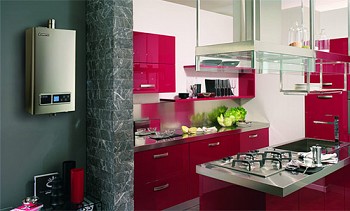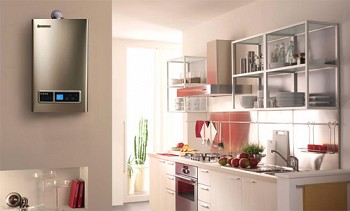There is always a need for hot water: bathing, washing dishes, cleaning. With a centralized supply, shutdowns are inevitable for a couple of weeks a year for maintenance work. In the case of a private house, the arrangement of hot water supply is completely left to the owners.
To understand how to choose a water heater, you need to know their types, operating principle, advantages and disadvantages. This will help to correctly determine the type, power and performance, and not regret the purchase.
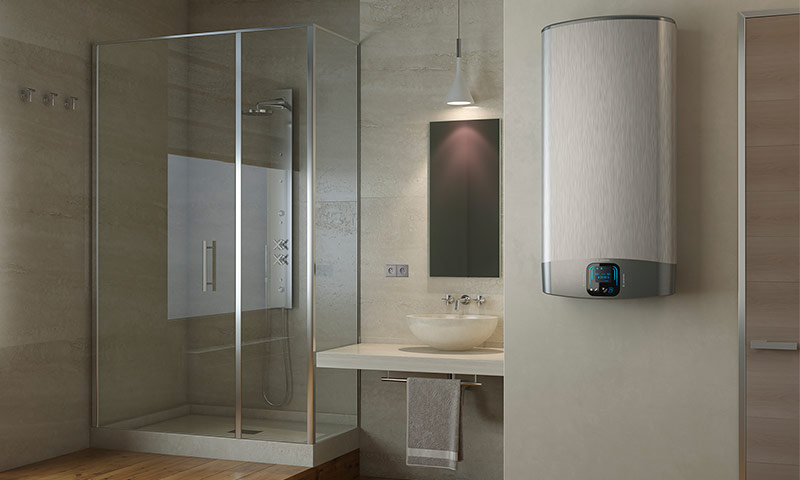
Content:
Varieties of water heaters, their device, principle of operation and selection criteria
Units for heating water are divided into two large categories: electric and gas. Each species is divided into two types: flowing and accumulative. To understand which water heater is better to choose consider in detail the device and the principle of operation of each, as well as their advantages and disadvantages.
Electric instantaneous water heaters
Equipment of this type is small and hung on the wall. It can be a kitchen or a bathroom. The instantaneous water heater is connected to the central water supply and is designed to heat water only in real time, i.e. only the one that flows through it when the user opens the tap.
This allows you to have hot water every time it is needed, and not to pay for its on-demand heating if the family is resting, is away from home or is engaged in other activities.
The device is an instantaneous electric water heater.
The device of an electric instantaneous water heater includes the following elements:

1. Thermal safety switch.
2. Copper heating unit.
3. Electronic control unit.
4. Temperature sensor.
5. Terminal block for wiring.
6. Flow sensor.
7. Hot water outlet.
8. Cold water inlet.
Heating elements of flow models are tubular or spiral. In some household appliances, two heating elements are installed at once, which allows you to stepwise control the heating temperature depending on the need to urgently receive very hot water. More expensive water heaters have a display to display the outlet temperature and the ability to visually see the parameters of the entered settings.
The principle of operation of an electric instantaneous water heater.
The principle of operation of a flowing electric water heater is the device of its heating element. This is a copper tube connected to the supply wires. When the cold water supply opens, the device automatically turns on and passes current through the heater. The water flowing through it immediately takes the heat received and at the outlet heats up to 45-50 0FROM.
To ensure fast heating of the duct, high power is needed. Therefore, the simplest flow-type water heaters have an indicator of 2 kW. Medium models work with a consumption of 5-7 kW, and units for 10-30 kW are designed to organize water heating with many sampling points.
During operation, a red indicator is lit, indicating that the device is functioning properly. If the heater and the liquid in it overheat from prolonged operation, the sensor sends a signal to the relay and turns off the power. When the key nodes have cooled, the machine starts up again.
What features to look for when choosing.
1. The most important selection parameter is productivity measured in liters per minute.The simplest models are able to heat up to 1-2 l./min, and more powerful ones up to 4-6 l./min.
2. The second indicator will be energy consumption, which should correspond to the network parameters in the building.
3. Electric instantaneous water heaters are divided into pressureless and pressure. The design of the former is not designed to constantly maintain pressure from the water supply system, so an overhead tap is placed in front of the device body. The feed is opened immediately before using the appliance, and then shut off.
Such models are equipped with their own sink tap and shower head. But there can only be one selection point. Due to the limited functionality, non-pressure devices are optimal for temporary use on days when centralized supply is turned off or for organizing a shower in a suburban country house.

Non-pressurized instantaneous water heater.
Pressure models can be integrated into the water supply system and distribute heated water from them to several points of selection (in the kitchen, in the bathroom, in the bath). The heating elements of these devices are more durable and are able to constantly withstand internal pressure. Such water heaters serve as the main generator of hot water throughout the year.

Pressurized instantaneous water heater.
4. Instantaneous water heaters are divided according to the method of temperature control.
The simplest is hydraulic. Its work is provided by a flow sensor that responds to the presence of water in the heater and starts the operation of the device. When the pressure drops, the device turns off. To set the temperature, a mechanical power switch is provided, which allows the liquid to be warmer in winter and cool in summer.
But such a performance can bring surprises when the pressure in the system drops sharply (someone opened another tap in the kitchen) or increases. Then the jet becomes unexpectedly hot or cold.
With electronic regulation, an automatic pressure analysis and regulation of the heating power takes place. On such water heaters there is a display for setting a comfortable temperature, and maintaining a given level is carried out by limiting the passable volume or increasing the power. These are more convenient household appliances, but they cost more.

Instantaneous water heater with electronic temperature control and multi-function display.
The most advanced instantaneous water heaters are equipped with a self-diagnosis function and are capable of finding breakdowns. The device reports this on the display with an error code. The last difference in the category is the maximum temperature to which the apparatus is able to heat water.
The indicator varies from 45 to 65 degrees. At one sampling point, a value of 45 degrees is enough, and in the case of two or more, the flow will not have time to warm up, so indicators of 55 degrees and above are needed.
Advantages and disadvantages of electric instantaneous water heaters.

+ The advantages of electric instantaneous water heaters.
- low starting cost of the simplest models;
- payment only for heating used water;
- compact sizes and easy installation;
- long service life;
- mobility (can be easily disconnected and transported to another place).

- Cons of electric instantaneous water heaters.
- need good wiring and stable voltage in the house;
- the number of sampling points depends on power;
- with hydraulic adjustment, it is more difficult to control the temperature;
- consume more electricity than storage devices;
- when the voltage is turned off in the house, users are left without thermal water.
Electric storage water heaters
Accumulative water heaters or boilers are radically different from flow models. They have a large case, inside of which there is a capacious tank. In its design a heater is implemented, which carries out the heating of the liquid. Bringing it to a temperature of 60-70 degrees, the device goes into economy mode and only maintains the set temperature.
The device of the storage electric water heater.
The storage water heater consists of the following elements:

1. The outer casing.
2. Thermal insulation.
3. Temperature indicator.
4. Wall mounts.
5. Hot water pickup tube.
6. Inner tank.
7. TEN.
8. Magnesium Anode
9. Temperature adjustment knob.
10. The supply of cold water.
The principle of operation of a storage electric water heater.
The principle of operation of a storage water heater is to heat a large volume of water in its own tank. For this, the heater of such a water heater is immersed in or in contact with it through a heat exchange tube. A voltage of 220 V is supplied to the heating source, which is converted into heat and given to the liquid.
This technique crashes into a central water supply system. A separate line with already heated water is fed into the mixer, where it is mixed with cold to set a comfortable temperature. As the heated stock is consumed, the capacity is replenished, and the temperature sensor monitors the maintenance of the desired level. If there was a blackout, the tank will keep the temperature high for a long time.
Since the boiler heats up the accumulated volume gradually, there is no need for high power. A 1.5-2 kW installation will cope with a large tank, but you will have to wait a bit. This allows the use of storage water heaters in houses with old wiring or cottages, where the voltage is often underestimated, and not create overloads on the network.
If the pressure in the tank exceeds the pressure set by the manufacturer (most often 8 atm), the safety valve is activated and part of the liquid enters the system.
What features to look for when choosing.
This type of equipment is widely used in private houses and apartments, as well as in showers of small enterprises.
1. The main differences between boilers are their capacity and tank volume. The higher the power, the faster the water heats up. For example, a model with a 1.5 kW heater will bring a liquid of 50 l to a temperature of 60 degrees in 120 minutes. Therefore, household appliances with an indicator of 3-5 kW will make it 2-3 times faster. The number of heating elements is 1 or 2, which also affects the heating time.
2. The size of the tank depends on water consumption. The smallest are 30 liter tanks, and the leaders among large boilers will be 250 liter models. Which water heater to choose in this case depends on the size of the family. Usually, a calculated value of 30-50 liters is taken per person. Therefore, for a family of three people need a model from 100 liters.
3. Accumulative water heaters are also divided by the material of the walls of the inner tank. Due to constant contact with water, this is the most vulnerable spot, with emerging corrosion.
Among the wall coating options are the following:
- Enamelled steel is the cheapest kind of coating on the walls of kitchen pots. It lasts a long time, but the enamel may crack due to a sharp temperature drop.
- Stainless steel is a medium-priced option, mostly not susceptible to corrosion, but welds can rust due to the high temperature from welding. If the model has additional processing of the seams and the anode, then you can safely take it.
- Glass ceramics are the most expensive and hardy type of container walls. No corrosion and no additional processing. The only thing that is important is to be careful during delivery and installation so that the tank does not crack.
- Copper - does not rust, but due to its softness it is impossible to make large-capacity tanks. A maximum of 30-50 liters, which is suitable only for one user.
4. The next is the type of heating element. It is wet and dry. The first is directly immersed in a liquid, therefore, over time it accumulates on the coating and its heat transfer efficiency decreases. The second functions through a special capsule and is completely protected from contact with water. Dry type machines last longer, but cost three times more.

Dry heater.

Wet heater.
5. Storage water heaters differ in the type of anode used. An anode is a rod that causes an oxygen reaction to itself due to its increased activity. The simplest material for this is magnesium. Over time, it collapses and needs to be replaced.
A more expensive form is the active anode of titanium. It is constantly connected to a voltage that is electronically controlled depending on the potential difference. Titanium does not collapse, so you don’t have to change anything, but when the light turns off, the tank remains without corrosion protection.
6. In addition, storage water heaters are divided by size, horizontal or vertical placement and weight. All this affects the installation location. Most models of 30-100 liters can be hung on the wall (in the kitchen, in the bathroom, in the bathroom above the toilet). 150-250 l units are recommended to be installed on the floor.

Accumulator heater of horizontal execution.

Accumulative water heater of vertical design.
An important indicator is the maximum temperature, ranging from 60 to 75 degrees. How many sampling points can be equipped with such a boiler depends on this.
7. A useful function is the timer, which allows you to program the device to be turned on for a time when users come from work or wake up. Then the equipment will be able to save electricity and not work to maintain heat all night or day until the owners need water. But for this, a household appliance must have a display and a programmer, which increases its cost.
Advantages and disadvantages of electric type storage water heaters

+ Advantages of an electric storage water heater.
- economical energy consumption due to low-power heating elements;
- long-term preservation of heat when turning off the light;
- no network congestion;
- You can equip several points of selection (conclusions on the kitchen, bathroom).

- Cons of electric storage water heater.
- long-term heating of the tank;
- difficult installation;
- take up a lot of space;
- higher cost;
- need maintenance to replace the anode;
- over time, plaque forms, which reduces heat transfer;
- corrosion of the tank or seams, which makes the whole apparatus unusable.
Gas instantaneous water heaters
Flowing gas water heaters are suitable in places where the gas pipeline is connected. But there are models that function from liquefied gas. The economy of their use is determined by the tariffs for electricity and gas in a particular region.
Since a much larger volume than 1 kW of electricity can be heated with one cubic meter of gas, even if the price of electricity is several times lower than gas, the use of gas is still more justified. But the installation of gas equipment is difficult due to the need not only to crash into the water supply and gas line, but also to organize smoke removal.
The device of a gas instantaneous water heater
A flow-type gas water heater is popularly called a gas column.
The device of a flowing gas water heater

1. Traction detector;
2. Overheat detector;
3. Gas-burner;
4. Gas flow regulator;
5. Hot water outlet
6. Exit for a chimney;
7. Manifold for combustion products;
8. Heat exchanger;
9. Gas pipe;
10. Water intake regulator;
11. Outlet for cold water.
The principle of operation of a gas instantaneous water heater.
The column heats the water due to the heat of the gas flame. For this, the heat exchanger is connected to the central water supply. All modern gas water heaters are equipped with automatic ignition. Ignition can be organized using a non-volatile battery-powered system or using a hydro generator. In a system with a hydrogenerator, a device is integrated into the system that generates current from a water stream. The system is activated after opening the tap.
Carbon monoxide goes through the chimney to the street. Sensors monitor the presence of water pressure and flame, the temperature of the liquid.If the valve closes, the system dies. In the event of an accidental disappearance of the flame, the gas supply stops.
The heat exchangers of instantaneous gas water heaters are made of copper, therefore they are reliably protected from corrosion. The temperature of an open flame reaches 200 degrees, so such devices have high performance up to 16 liters of hot water per minute.
Power adjustment is carried out by changing the flame force or the transmitted volume of the liquid. In addition to mechanical control, there are electronic versions with a board that receives signals from temperature and pressure sensors. Depending on their readings, the device modulates the flame and maintains a predetermined outlet temperature.
What features to look for when choosing.
Geysers are usually installed in the kitchen or in the boiler room by hanging on the wall. They do not require much space due to the compact size of the case. Weight of equipment from 6 to 12 kg is not a problem for installation.
There are gas columns with an open combustion chamber and a closed one. The former are simple and take air from the room. They work from natural traction, so they require less maintenance and are cheaper. Closed-chamber heaters need a coaxial chimney to provide air from the street and smoke removal at the same time. In view of this, their installation is more complicated, but the operation of such a column does not affect the indoor climate and they are safer, and therefore cost more.

Geyser with a coaxial chimney.
Geysers can work not only from the highway, but there are models and connected to cylinders, which is especially practical in the country for temporary use.
When choosing a gas-type flow heater, it is important to pay attention to the presence of protective functions: gas control sensor, traction control, water sensor in the system. This will protect users as much as possible. Models with electronic or hydraulic ignition are more economical because they do not waste gas while the column is idle.
Pros and cons of a gas instantaneous water heater.

+ The advantages of gas instantaneous water heaters
- high performance;
- heating only the water that is used here and now;
- more economical in resource costs than electric models;
- are cheaper than boilers;
- most are able to work without electricity;
- You can organize up to 3 points of selection.

- Cons of gas instantaneous water heaters
- require complex installation with a chimney and insert into the gas pipeline;
- need maintenance by specialists;
- pose an increased risk due to gas handling.
Gas storage water heaters
Gas storage water heaters are not the most popular category of equipment, because they are expensive and can only work from a permanent gas main. And in this case, it is advisable to install a double-circuit boiler with an indirect heating boiler, which costs the same, but can work both for heating the house and for heating the water.
But the choice of a water heater of this type can be justified in a house or apartment located in the village, where the pressure of the water is often very weak. In this case, this is not enough for the column. And if the voltage also often drops, then the only output will be a small-volume storage gas water heater of 50-95 liters.
Still such a choice is optimal for pools and showers of manufacturing enterprises, where there is a massive intake of hot water at peak hours and there are many points of selection. Then no other model can cope with the existing needs. And gas storage devices can have a tank of up to 350 l, which is completely heated in 12 minutes.
The device of gas storage water heaters.
Gas storage water heater consists of:

1. Gas check valve;
2. Gas adjustment knob;
3. Water temperature adjustment;
4. Gas-burner;
5. Ignition gas wick;
6. Thermocouple;
7. Nozzle of the main gas burner;
8. Inner protective coating;
9. Thermal insulation of water tanks;
10. External protective cover;
11. Damper;
12. Anode to prevent scale and corrosion;
13. Drain cock;
14. Cable from the traction detector;
15. Chimney base;
16. Divider;
17. Cold water supply pipe;
18. Swirl water flows to intensify mixing;
19. Emergency Relief Valve Socket;
20. Pipe leaving for hot water;
21. Traction stabilizer.
The principle of operation of storage devices.
Unlike electric models, high performance is ensured thanks to long burners and a wide gas duct, the diameter of which reaches 90 mm. A divider is located inside, which contributes to a small delay in hot smoke.
The gas duct extends through the entire length of the tank, so heat transfer is very fast. 12-17 minutes of burner operation provide heating of a large volume to a temperature of 45 degrees. The equipment needs a flue for which they mount a channel with access to the street. Sensors monitor the flame, gas pressure, water temperature and regulate the burning force thanks to the electronic signals. In simpler water heaters, this is done by the user manually, reducing or increasing the height of the flame.
What features to look for when choosing.
Accumulative gas water heaters can be wall or floor, depending on their size. The most compact are 700x500x500 mm, while the larger ones reach 2300x700x800 mm. Therefore, it is important to consider the dimensions of the equipment in advance, so that there is where to install a rather big case.

Floor storage gas water heater.
The capacity of water heaters, which can have an indicator of 50-350 liters, also depends on the dimensions. But here it is not necessary to adhere to the calculated value of 1 person = 30-50 liters, since heating takes place in 10-25 minutes. Therefore, the main factor is still the dimensions in height and width.
When choosing, you don’t have to think about the material of the walls of the tank for a long time - almost all models are made of steel and enameled. Combustion chambers are open and closed, which affects the complexity of installation (the latter have a more difficult smoke removal system).
Advantages and disadvantages of gas storage water heaters.

+ Advantages of storage gas water heaters.
- the ability to work with low water pressure in the system;
the highest productivity among all types of household devices for heating liquids; - There are models that are independent of electricity (ignition and operation of sensors), so you can have warm water even when the lights are turned off.

- Cons of storage gas water heaters.
- high cost;
- installation complexity;
- the need for maintenance of gas equipment;
large dimensions and heavy weight.
How to determine the type of water heater
Having examined the device, the principle of operation and the types of water heaters, you can go to tips for choosing the type, depending on the operating conditions. First of all, it’s worth understanding how often the appliance will be used: all year round or a couple of weeks during a central hot water outage?
1. If household appliances are bought as an auxiliary tool, then spending a large amount and taking up a lot of space in the bathroom does not make sense. There will be enough electric instantaneous water heater, which can easily cope with providing thermal water to the kitchen and shower. When washing dishes in a dishwasher, you can do without a pressure model with one selection point for a shower.
2. But if you need to warm water every day, then you need to consider various factors. It is advisable to install a gas instantaneous water heater in houses and apartments with gas. Such equipment does not take up much space, does not create network loads and has high performance (you can wash dishes and bathe at the same time). But if the water supply is weak, then the flowing type will not be able to work fully and here you need to turn your attention to the other two types.
3. An electric boiler is suitable for cottages, country houses, apartments. This option is also optimal due to the low power of the heating element, which does not create overload on the wiring. But the maximum number of users will be limited to 5-7 people, even with the most productive version. Still, this technique will not be effective if the power line often experiences subsidence.
Then the heating element will not work at full power, which will further increase the heating time. In this case, you need to buy a voltage stabilizer.
4. To organize a shower in production, you should pay attention to models with a power supply of 380 V, which are more productive. With even greater needs for volumes of hot water and a low pressure of cold, a gas storage heater should be preferred.
How to determine the power and performance of the device
The concepts of power and performance of water heaters are inextricably linked, but are calculated differently, depending on the type of equipment.
Power and performance of electric storage water heater
In the case of choosing a storage electric water heater, its power can vary from 1.5 to 5 kW, which determines the time of heating the tank. No matter what power you have to turn on the device in advance and wait for the water to heat up.
Therefore, when choosing, you need to consider only the displacement of the tank, so that it is enough to wash all family members without re-waiting for heating. This is calculated by the formula 1 person = 30-50 liters. Therefore, for a family of four people need a boiler of 120-200 liters.
Power and performance of a gas storage water heater
In gas storage models, due to high productivity, the heating time of a tank of 50-300 l can take 12-24 minutes, so buyers almost do not pay attention to this indicator. For a family of three people, you can purchase equipment with a small tank of 50 liters and the liquid will still have time to heat up between the change of users.
Power and performance of a geyser
Gas instantaneous water heaters have a capacity of 5 to 16 liters per minute:
- For two selection points (someone washes the dishes, and someone bathes at this time), a minimum of 5 l / min is sufficient.
- For a house with several bathrooms, it is practical to choose a water heater with a capacity of 10 l / min.
- If the house also has two kitchens, then models with a productivity value of 16 l / min are suitable.
Power and productivity of a flowing electric water heater
The most important is the selection of power and performance of instantaneous electric water heaters, because if you make errors in the parameters in the winter you can swim in cool water. This is due to the difference in the temperature of the liquid in the central water supply in the summer (+ 15- + 20 degrees) and winter (+5 degrees) season.
To make it comfortable at the outlet, the temperature should reach 45-50 degrees. You can find out whether the device can cope with this at different times of the year or not with the help of the calculation standard: 1l / min = 2 kW = 30 degrees.
This means that a 2 kW device will be able to heat the stream at a speed of 1 liter per minute, 30 degrees above the input value. If in summer a liquid with a temperature of +15 degrees enters it, then the output will be +45, which is very comfortable. But in winter, when entering +5, the output will be +35 degrees, so for winter use you need to choose models from 4 kW.
When calculating the performance of a flowing electric water heater, the number of sampling points is also important. If a 4 kW model will heat water for two taps, then the trickle will be very thin (after all, about 5-10 liters flow through one tap per minute), therefore, in this case, power from 6 kW is needed, which will automatically increase productivity.
Having studied all the nuances of choosing a water heater, it is much easier to determine the type and its parameters and proceed to consider specific models.This will help not to become a victim of advertising or intrusive sellers, and buy exactly the product that will fully comply with specific operating conditions.

